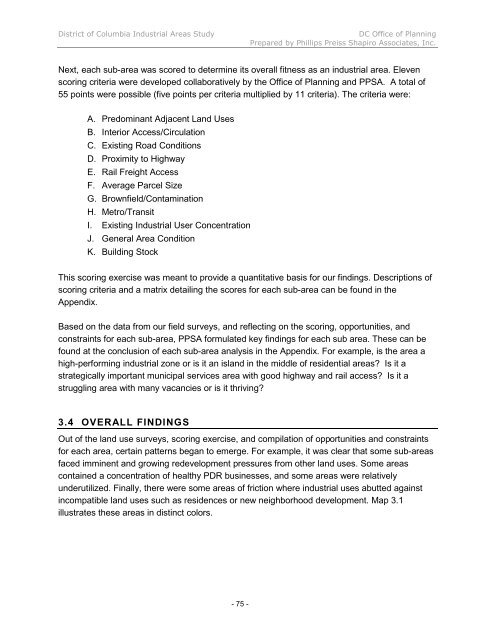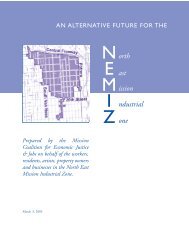INDUSTRIAL LAND IN A POST-INDUSTRIAL CITY District of ...
INDUSTRIAL LAND IN A POST-INDUSTRIAL CITY District of ...
INDUSTRIAL LAND IN A POST-INDUSTRIAL CITY District of ...
You also want an ePaper? Increase the reach of your titles
YUMPU automatically turns print PDFs into web optimized ePapers that Google loves.
<strong>District</strong> <strong>of</strong> Columbia Industrial Areas Study DC Office <strong>of</strong> Planning<br />
Prepared by Phillips Preiss Shapiro Associates, Inc.<br />
Next, each sub-area was scored to determine its overall fitness as an industrial area. Eleven<br />
scoring criteria were developed collaboratively by the Office <strong>of</strong> Planning and PPSA. A total <strong>of</strong><br />
55 points were possible (five points per criteria multiplied by 11 criteria). The criteria were:<br />
A. Predominant Adjacent Land Uses<br />
B. Interior Access/Circulation<br />
C. Existing Road Conditions<br />
D. Proximity to Highway<br />
E. Rail Freight Access<br />
F. Average Parcel Size<br />
G. Brownfield/Contamination<br />
H. Metro/Transit<br />
I. Existing Industrial User Concentration<br />
J. General Area Condition<br />
K. Building Stock<br />
This scoring exercise was meant to provide a quantitative basis for our findings. Descriptions <strong>of</strong><br />
scoring criteria and a matrix detailing the scores for each sub-area can be found in the<br />
Appendix.<br />
Based on the data from our field surveys, and reflecting on the scoring, opportunities, and<br />
constraints for each sub-area, PPSA formulated key findings for each sub area. These can be<br />
found at the conclusion <strong>of</strong> each sub-area analysis in the Appendix. For example, is the area a<br />
high-performing industrial zone or is it an island in the middle <strong>of</strong> residential areas? Is it a<br />
strategically important municipal services area with good highway and rail access? Is it a<br />
struggling area with many vacancies or is it thriving?<br />
3.4 OVERALL F<strong>IN</strong>D<strong>IN</strong>GS<br />
Out <strong>of</strong> the land use surveys, scoring exercise, and compilation <strong>of</strong> opportunities and constraints<br />
for each area, certain patterns began to emerge. For example, it was clear that some sub-areas<br />
faced imminent and growing redevelopment pressures from other land uses. Some areas<br />
contained a concentration <strong>of</strong> healthy PDR businesses, and some areas were relatively<br />
underutilized. Finally, there were some areas <strong>of</strong> friction where industrial uses abutted against<br />
incompatible land uses such as residences or new neighborhood development. Map 3.1<br />
illustrates these areas in distinct colors.<br />
- 75 -












